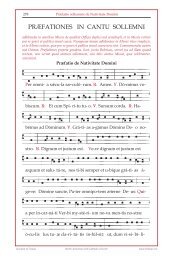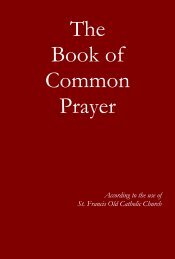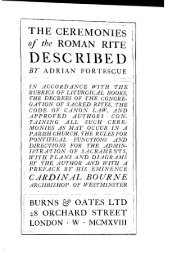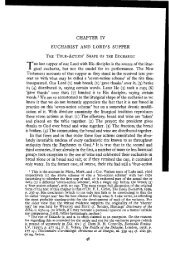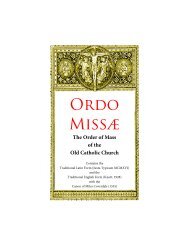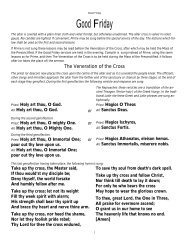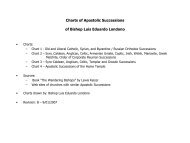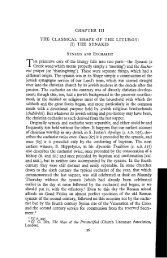Official Record of Apostolic Succession of
Official Record of Apostolic Succession of
Official Record of Apostolic Succession of
You also want an ePaper? Increase the reach of your titles
YUMPU automatically turns print PDFs into web optimized ePapers that Google loves.
Msgr. Aglipay himself) continued to be asked. The Protestant Episcopal Church in The United States <strong>of</strong><br />
America provided the answer in 1948.<br />
The Protestant Episcopal Church, looking back on its history, found that it had completely missed the mark<br />
when it refused to establish a vital episcopacy in Mexico in the late 1920's. After an assignation attempt on<br />
the life <strong>of</strong> the Mexican President and his cabinet members (allegedly traced to the Roman Catholic prelates<br />
and clergy in Mexico), Presidente Plutarco Elias Calles vowed to establish a Mexican National Catholic<br />
Church separate from and independent <strong>of</strong> Rome.<br />
The Protestant Episcopal Church in the USA turned down the Mexican request and Presidente Calles finally<br />
obtained the <strong>Apostolic</strong> <strong>Succession</strong> for the Mexican National Catholic Church from Msgr. Carmel Henry<br />
Carfora, Archbishop <strong>of</strong> Chicago <strong>of</strong> the Old Roman Catholic Church.<br />
Although three Bishops were consecrated to initiate the Mexican hierarchy (Jose Joaquin Perez y Budar,<br />
Antonio Lopez Sierra and Dr. Macario Lopez Valdes), the "Nationalistas" (as they were called), failed to<br />
replace The Church <strong>of</strong> Rome in Mexico and today only one remnant parish in Mexico and the East Los<br />
Angeles parish <strong>of</strong> Bishop Emil F. Rodriquez y Fairfield remain. Unlike the Filipinos, the Mexicans demanded<br />
continued celibacy in their national independent Church and were unable to recruit new priests.<br />
Near the turn <strong>of</strong> the nineteenth century, some Protestant Episcopal Bishops (such as Charles Chapman<br />
Grafton, who became Bishop <strong>of</strong> Fond du Lac, Wisconsin in 1888), espoused the so-called "Three Branch<br />
Theory" <strong>of</strong> the Church. The idea was that one branch was The Church <strong>of</strong> Rome, another branch was the<br />
Orthodox Church under Constantinople, and the third branch was The Church <strong>of</strong> England. Thus, it was<br />
thought, the Protestant Episcopal Church in the U.S.A. would eventually become the TRUE American<br />
Catholic Church; and in a time before The Church <strong>of</strong> Rome was firmly established in the United States,<br />
PECUSA had high hopes.<br />
It was the echo <strong>of</strong> this Branch Theory <strong>of</strong> Bishop Grafton that prevented the PECUSA from acting in the case<br />
<strong>of</strong> Mexico, and thus lost to the non-papal Christians the whole country <strong>of</strong> Mexico which, having cast out The<br />
Church <strong>of</strong> Rome and Her clergy, might have brought into the country the enlightenment that PECUSA<br />
claimed was Hers. But they did nothing until it was too late to do anything. The ideal was one branch only<br />
per country, and this idea blinded PECUSA's eyes at that time.<br />
PECUSA did not again want to miss the opportunity for missionary advancement. When, after several years<br />
<strong>of</strong> correspondence, Isabelo de los Reyes, Jr., became the leader <strong>of</strong> the Philippine national Church, PECUSA<br />
set aside the Branch Theory for one <strong>of</strong> "side-by-side" jurisdictions in the same land.<br />
On April 7, 1948, Isabela de los Reyes, Jr., and two other native bishops were consecrated to the Sacred<br />
Episcopacy by Bishop Norman S. Binstead <strong>of</strong> the PECUSA Missionary District <strong>of</strong> The Philippines, assisted<br />
by his suffragan (Bishop Robert F. Wilner) and the Rt. Rev'd Harry S. Kennedy (PECUSA Bishop <strong>of</strong><br />
Honolulu).<br />
The three newly consecrated Philippine prelates then consecrated all the other native Bishops and ordained<br />
all priests and deacons according to the PECUSA rite.<br />
The <strong>Apostolic</strong> <strong>Succession</strong> obtained by the Philippine Independent Church was that <strong>of</strong> PECUSA - from The<br />
Church <strong>of</strong> England. A few years later, when European Old Catholics assisted in Filipino Episcopal<br />
consecrations, the Old Catholic Lines <strong>of</strong> the European Bishops were added.<br />
For many years the Independents and the Philippine Episcopalians walked side by side in harmony.<br />
However, over the years, differences developed. The "High Church" versus the "Low Church" problems <strong>of</strong><br />
the Episcopalians in the USA did not appear as such in The Philippines, the conflicting parties rather<br />
seemed to be grouped as Pro-Protestant (or Pro-PECUSA) and Pro-Catholic.<br />
More recently groups have favored former President Ferdinand Marcos who, as an infant, was baptized into<br />
the Independent Church by Msgr. Gregorio Aglipay himself. President Marcos had helped finance the<br />
Aglipay National Shrine which served as the Cathedral <strong>of</strong> Bishop Manuel Lagasca. Even as President<br />
Marcos <strong>of</strong>ten favored the Independent Church until his conversion and political position as a Roman



